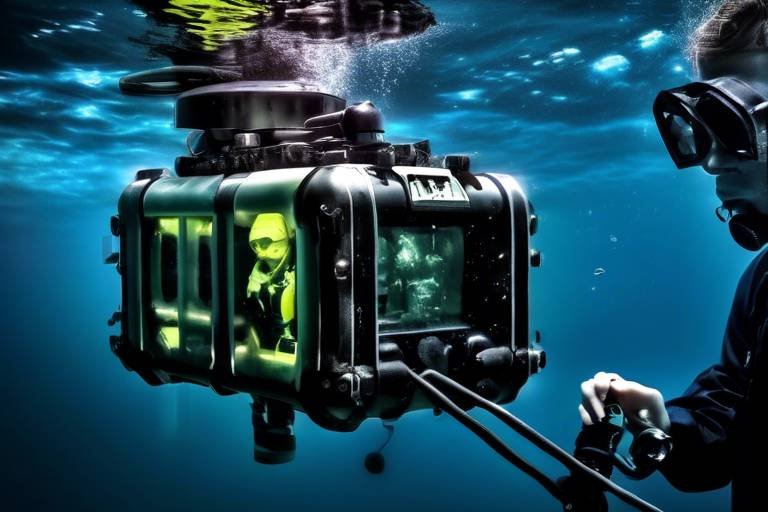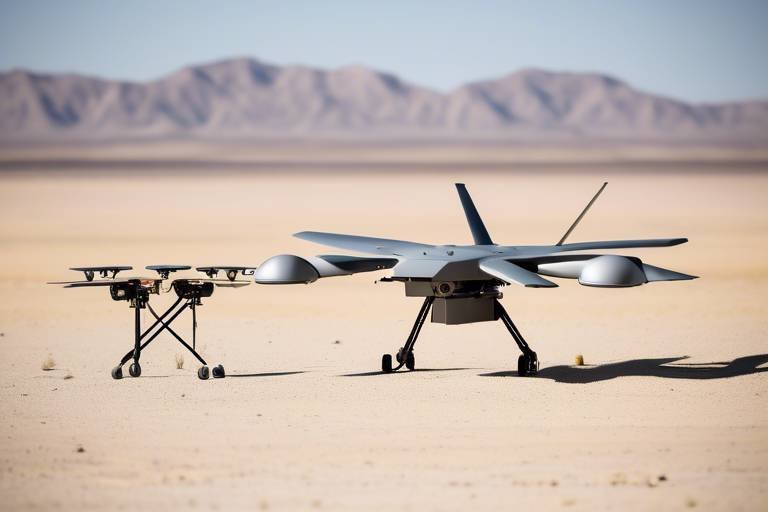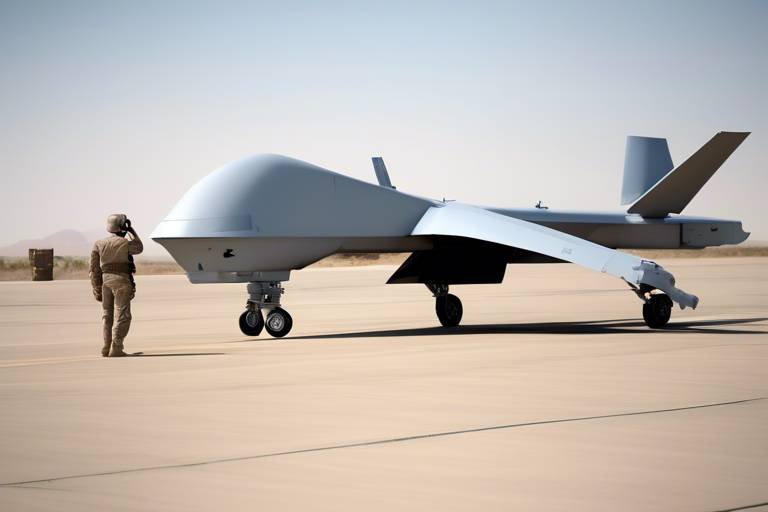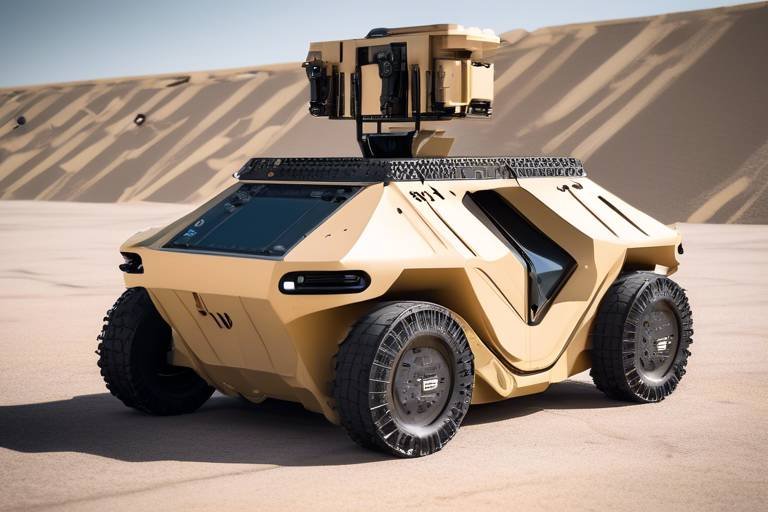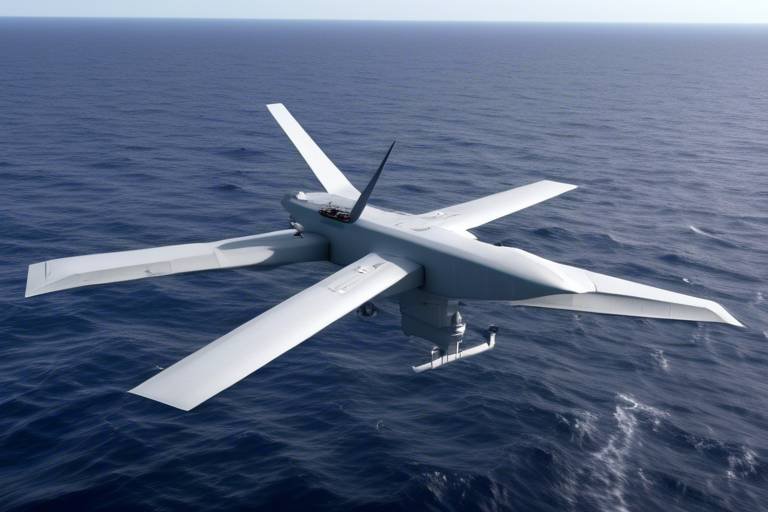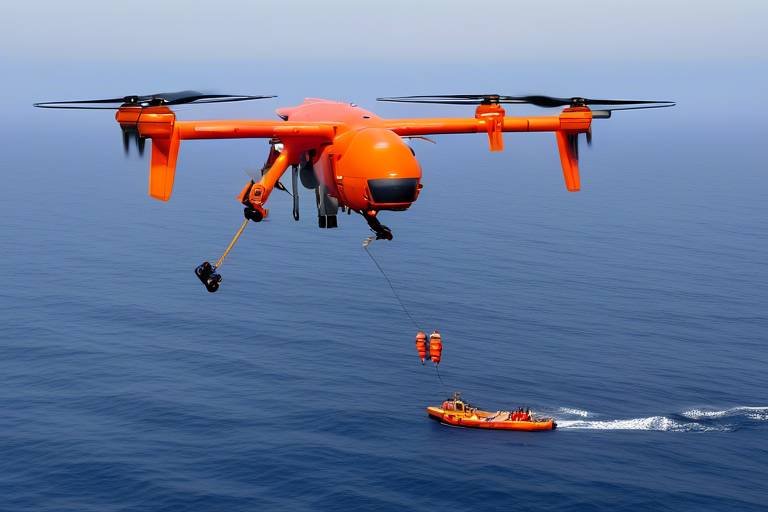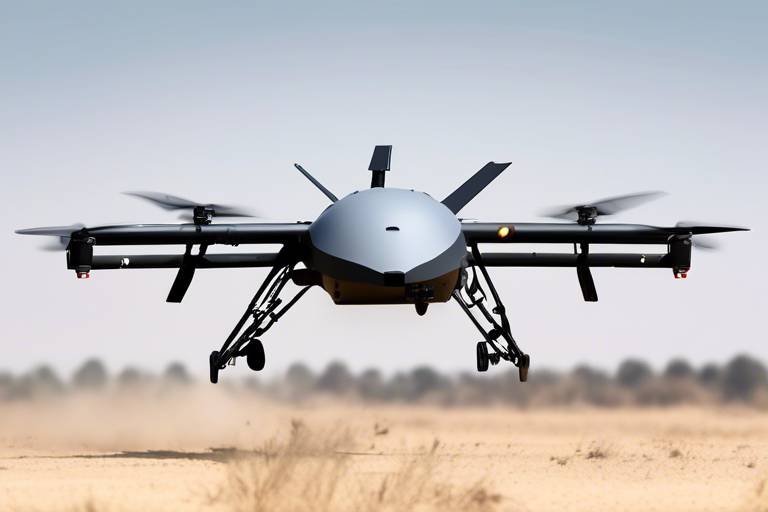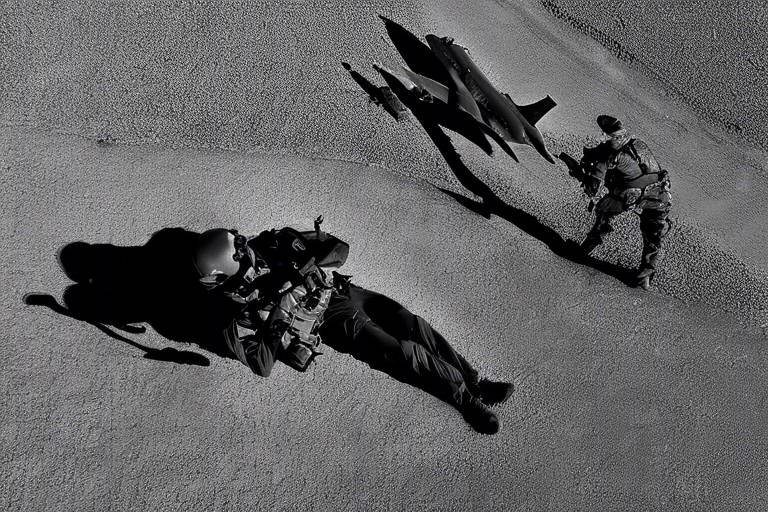Analyzing the Effectiveness of the ROV in Underwater Operations
The world beneath the waves is a mysterious and often inaccessible realm, teeming with life and secrets waiting to be uncovered. Enter the Remotely Operated Vehicle (ROV), a technological marvel that has revolutionized underwater operations across various industries. ROVs are not just toys for ocean exploration; they are sophisticated machines designed to perform an array of tasks that would be perilous or impossible for human divers. In this article, we will delve into the effectiveness of ROVs, exploring their capabilities, advantages, challenges, and the exciting future developments that lie ahead.
ROV technology has come a long way since its inception. Initially developed for military applications, these vehicles have evolved into essential tools for marine research, oil and gas exploration, and underwater construction. ROVs are typically equipped with cameras, lights, and manipulative arms, allowing them to capture high-definition images and perform intricate tasks in the depths of the ocean. The fundamental principle behind ROV operation is simple: they are controlled remotely from a surface vessel using a series of cables and sophisticated software, allowing operators to navigate and manipulate them with precision.
ROVs have found their place in a variety of sectors, showcasing their versatility and effectiveness. From scientific exploration to industrial applications, these vehicles are making significant contributions. Here are some of the key areas where ROVs are utilized:
- Marine Research: ROVs play a crucial role in studying marine ecosystems, enabling scientists to explore deep-sea habitats and gather data that would otherwise be unattainable.
- Oil and Gas Industry: In this sector, ROVs are indispensable for inspection, maintenance, and repair of underwater pipelines and equipment.
- Underwater Construction: ROVs assist in constructing underwater structures, providing visual feedback and performing tasks that require a steady hand.
In the realm of marine research, ROVs are akin to modern-day submarines, allowing scientists to venture into the depths of the ocean without the risks associated with human divers. Equipped with advanced sensors and cameras, ROVs enable researchers to collect critical data on marine life, underwater geology, and environmental conditions. They play a vital role in initiatives aimed at understanding climate change impacts on ocean ecosystems, making them invaluable in the fight to preserve our oceans.
The oil and gas industry has embraced ROV technology to enhance operational efficiency and safety. These vehicles are deployed for tasks such as inspecting underwater pipelines, conducting maintenance, and even performing repairs in real-time. By using ROVs, companies can minimize the risks associated with diving operations and significantly reduce downtime in their underwater drilling activities. The ability to gather real-time data and images from the seabed has transformed how these industries operate, leading to safer and more efficient practices.
The advantages of deploying ROVs in underwater operations are numerous and impactful. They not only improve safety but also offer a cost-effective solution for various underwater tasks. Here are some of the key benefits:
One of the most significant advantages of ROVs is the enhanced safety they provide. Human divers face numerous risks when working underwater, including decompression sickness, drowning, and exposure to hazardous environments. By utilizing ROVs, these risks are mitigated, as the machines can perform dangerous tasks remotely. Operators can control ROVs from the safety of a vessel, allowing for precise operations without the need for human presence in perilous conditions.
In addition to safety, ROVs offer substantial cost savings over traditional underwater operations. The deployment of ROVs can lead to reduced labor costs, fewer accidents, and minimized project delays. For instance, the cost of hiring and training divers can be significantly higher than operating ROVs. Furthermore, ROVs can operate in challenging conditions without the need for extensive safety measures that would typically be required for human divers, thus streamlining project budgets.
Despite their many advantages, ROVs are not without challenges. Understanding these hurdles is crucial for improving their effectiveness in underwater operations. Some of the primary challenges include:
ROVs can face technical limitations, particularly regarding maneuverability and power supply. In complex underwater environments, navigating tight spaces or strong currents can be challenging. Additionally, the power supply for ROVs is often limited, which can restrict their operational time and range. Continuous advancements in battery technology and propulsion systems are essential to overcome these technical constraints.
Environmental factors such as strong currents, low visibility, and extreme temperatures can significantly impact ROV operations. These conditions can hinder the vehicle's ability to perform tasks effectively and safely. To combat these challenges, operators must be well-trained and equipped with the latest technology to adapt to varying underwater environments.
Looking to the future, advancements in ROV technology are poised to enhance their capabilities further. Innovations in artificial intelligence, machine learning, and autonomous systems are likely to play a significant role in shaping the next generation of ROVs. Imagine ROVs that can make real-time decisions based on data collected from their surroundings, or even work collaboratively with other vehicles and human operators. The potential applications are exciting and could lead to breakthroughs in underwater exploration and industrial operations.
- What are ROVs used for? ROVs are used in various applications, including marine research, oil and gas exploration, and underwater construction.
- How do ROVs operate? ROVs are controlled remotely from a surface vessel using cables and sophisticated software, allowing for precise navigation and task execution.
- What are the safety benefits of using ROVs? ROVs significantly reduce risks to human divers by performing dangerous tasks remotely, enhancing overall safety in underwater operations.
- What challenges do ROVs face? ROVs encounter challenges such as technical limitations, environmental factors, and operational costs that can impact their effectiveness.

Introduction to ROV Technology
Remotely Operated Vehicles, or ROVs, represent a fascinating intersection of engineering and exploration, designed to navigate the often treacherous depths of our oceans. Developed in the late 20th century, these sophisticated machines have evolved significantly, incorporating advanced technology that allows them to perform a variety of tasks underwater. At their core, ROVs are unmanned, remote-controlled submarines equipped with cameras, sensors, and robotic arms, enabling them to carry out operations that would be perilous for human divers.
One of the most striking features of ROV technology is its ability to operate in extreme conditions. Whether it's the crushing pressures of deep-sea environments or the murky waters of a lake, ROVs are engineered to withstand these challenges. The design of an ROV typically includes a robust frame, buoyancy control systems, and powerful thrusters, all of which contribute to its maneuverability and stability underwater. This allows them to be used in various scenarios, from scientific research to industrial applications.
Fundamentally, ROVs function based on a simple yet effective principle: they are tethered to a surface control unit via a cable, which supplies power and facilitates communication. This tethering system allows operators to maintain a real-time connection with the vehicle, enabling precise control over its movements and operations. The operational range of ROVs can vary widely, with some capable of reaching depths of over 6,000 meters, making them invaluable for deep-sea exploration.
As we delve deeper into the world of ROV technology, it's essential to understand the various components that make these vehicles so effective. Most ROVs are equipped with:
- Cameras: High-definition cameras provide live video feeds, allowing operators to see and assess underwater conditions.
- Sensors: These can measure temperature, pressure, and even detect chemical compositions, providing crucial data for research and industry.
- Manipulators: Robotic arms equipped with tools enable ROVs to perform tasks such as sample collection or equipment repairs.
In summary, ROV technology is a remarkable achievement that enhances our ability to explore and understand underwater environments. As we continue to refine these technologies, the potential applications seem limitless, from environmental monitoring to underwater archaeology. The next sections will explore the various applications of ROVs, showcasing their contributions to different sectors.
- What are ROVs used for? ROVs are used in various applications, including marine research, oil and gas exploration, underwater construction, and environmental monitoring.
- How deep can ROVs go? Depending on their design, some ROVs can reach depths of over 6,000 meters.
- Are ROVs safe to operate? Yes, ROVs significantly reduce the risks associated with human divers by performing dangerous tasks remotely.
- What kind of data can ROVs collect? ROVs can collect video footage, temperature readings, pressure measurements, and even chemical analyses of water samples.

Applications of ROVs
Remotely Operated Vehicles (ROVs) are revolutionizing various industries by providing innovative solutions for underwater tasks. These sophisticated machines are not just toys for the ocean; they are essential tools that enable us to explore, inspect, and interact with environments that are otherwise unreachable or too dangerous for human divers. From the depths of the ocean to complex underwater constructions, ROVs play a pivotal role in numerous applications.
One of the most significant applications of ROVs is in marine research. Scientists and researchers utilize these vehicles to explore the depths of the ocean, gathering crucial data about marine ecosystems. Imagine being able to send a robotic vehicle into the dark, unexplored depths of the sea, capturing stunning visuals and collecting samples without ever putting a human at risk. ROVs equipped with high-definition cameras and advanced sensors allow researchers to study the behavior of marine life, monitor coral reefs, and assess environmental changes due to climate change.
In addition to marine research, ROVs are invaluable in the oil and gas industry. These vehicles are employed for a variety of tasks, including inspection, maintenance, and repair of underwater pipelines and drilling rigs. The ability to operate remotely means that companies can conduct inspections without the need for divers, thereby enhancing safety and efficiency. For instance, ROVs can perform visual inspections and gather data on the condition of underwater structures, allowing for timely maintenance and reducing the risk of catastrophic failures.
ROVs are also making waves in the field of underwater construction. They assist in tasks such as laying cables, installing equipment, and even conducting surveys of potential construction sites. With their precision and ability to operate in challenging conditions, ROVs can perform tasks that would be incredibly risky or impossible for human divers. The versatility of ROVs makes them a critical asset in these operations, ensuring that projects are completed safely and efficiently.
To illustrate the diverse applications of ROVs, consider the following table that summarizes their key uses across different industries:
| Industry | Application |
|---|---|
| Marine Research | Deep-sea exploration, data collection, ecosystem monitoring |
| Oil and Gas | Inspection, maintenance, repair of underwater infrastructure |
| Underwater Construction | Installation of equipment, cable laying, site surveys |
In summary, the applications of ROVs are vast and varied, touching multiple sectors and enhancing our capabilities in underwater operations. As technology continues to advance, we can expect even more innovative uses for ROVs, further solidifying their role as indispensable tools in the underwater realm.
- What is an ROV? A Remotely Operated Vehicle (ROV) is an unmanned robot that can be controlled remotely to perform tasks underwater.
- How are ROVs used in marine research? ROVs are used to explore deep-sea environments, collect data, and study marine ecosystems without risking human divers.
- What advantages do ROVs offer in the oil and gas industry? ROVs enhance safety by performing inspections and maintenance tasks remotely, reducing the need for divers and minimizing risks.

Marine Research
When it comes to exploring the mysterious depths of our oceans, Remotely Operated Vehicles (ROVs) have become the unsung heroes of marine research. Imagine being able to dive into the deep blue without ever getting wet! ROVs enable scientists to venture into environments that are often too dangerous or inaccessible for human divers. These robotic marvels are equipped with high-definition cameras, sensors, and tools that allow researchers to gather invaluable data about marine ecosystems.
One of the most exciting aspects of ROVs in marine research is their ability to facilitate deep-sea exploration. With the ocean covering over 70% of our planet, there’s a treasure trove of biodiversity waiting to be discovered. ROVs can reach depths of up to 6,000 meters, where sunlight fails to penetrate, and life forms adapt in astonishing ways. For instance, they have been instrumental in uncovering new species, studying habitats, and understanding the impacts of climate change on underwater ecosystems.
Furthermore, ROVs play a crucial role in data collection. Equipped with various sensors, they can measure temperature, salinity, and pressure, providing researchers with real-time information about the underwater environment. This data is vital for modeling climate change effects, assessing fish populations, and monitoring coral reef health. In fact, many marine researchers rely on ROVs to conduct long-term studies that would be impossible to execute with human divers alone.
Another fascinating application of ROVs in marine research is their ability to conduct underwater mapping. Using sonar technology, ROVs can create detailed maps of the seafloor, revealing underwater topography and geological features. This information is not only crucial for scientific understanding but also for activities like habitat restoration and marine conservation efforts.
In summary, ROVs have revolutionized marine research by providing a safe, efficient, and cost-effective means of exploring and studying the ocean. Their ability to operate in extreme conditions and gather critical data makes them indispensable tools for scientists dedicated to unlocking the secrets of our oceans. As technology advances, we can only imagine the incredible discoveries that lie ahead, thanks to these remarkable underwater vehicles.
- What are ROVs used for in marine research? ROVs are primarily used for deep-sea exploration, data collection, underwater mapping, and studying marine ecosystems.
- How deep can ROVs go? Many ROVs can operate at depths of up to 6,000 meters, allowing access to some of the most remote areas of the ocean.
- What kind of data can ROVs collect? ROVs can gather data on temperature, salinity, pressure, and can capture high-definition video and images of marine life and habitats.
- Are ROVs safe for marine research? Yes, ROVs significantly reduce risks to human divers by performing dangerous tasks remotely, making underwater research safer and more efficient.

Oil and Gas Industry
When it comes to the oil and gas industry, Remotely Operated Vehicles (ROVs) have become nothing short of a game changer. Imagine trying to explore the depths of the ocean, where human divers face extreme pressure and unpredictable conditions. ROVs step in as the superheroes of this underwater realm, equipped with advanced technology that allows them to perform inspection, maintenance, and repair tasks with remarkable precision. These vehicles are not just tools; they are lifelines that enhance both safety and operational efficiency in this challenging sector.
One of the primary roles of ROVs in the oil and gas industry is conducting inspections. Whether it’s checking pipelines, subsea structures, or drilling rigs, ROVs can navigate through complex underwater environments that would be risky for human divers. By utilizing high-definition cameras and sophisticated sensors, these vehicles provide real-time data and visuals, allowing operators to make informed decisions without putting lives at risk.
Furthermore, ROVs play a crucial role in maintenance. They are equipped with robotic arms and tools that enable them to perform tasks such as tightening bolts, replacing components, and even conducting minor repairs on the seabed. This capability not only saves time but also significantly reduces the costs associated with deploying human divers for these operations. In fact, studies have shown that using ROVs can cut operational costs by up to 30% compared to traditional methods.
In addition to inspections and maintenance, ROVs are vital during the drilling process. They provide continuous monitoring of drilling operations, ensuring that everything runs smoothly. By utilizing ROVs, companies can detect potential issues early on, preventing costly failures and environmental disasters. This proactive approach not only enhances safety but also aligns with the industry's increasing focus on environmental sustainability.
However, the effectiveness of ROVs in the oil and gas sector is not without its challenges. Factors such as technical limitations and environmental conditions can impact their performance. For instance, strong underwater currents can make it difficult for ROVs to maintain stability, while visibility issues can hinder their ability to capture clear images. To mitigate these challenges, companies are continually investing in advanced technologies and training programs that enhance ROV capabilities.
As we look to the future, the oil and gas industry is poised for exciting developments in ROV technology. Innovations such as autonomous ROVs, capable of operating without human intervention, are on the horizon. This advancement could revolutionize underwater operations, making them safer and more efficient than ever before. The integration of artificial intelligence and machine learning will also enable ROVs to adapt to their environment, improving their maneuverability and decision-making capabilities.
In conclusion, ROVs have proven to be indispensable in the oil and gas industry. They not only enhance safety and operational efficiency but also pave the way for a more sustainable approach to underwater exploration and maintenance. As technology continues to evolve, we can expect ROVs to take on even more significant roles, ensuring that the oil and gas sector remains at the forefront of innovation.
- What are ROVs used for in the oil and gas industry?
ROVs are primarily used for inspection, maintenance, and repair tasks in underwater environments, enhancing safety and operational efficiency. - How do ROVs improve safety?
ROVs reduce the need for human divers in dangerous underwater tasks, minimizing the risk of accidents and injuries. - What challenges do ROVs face?
ROVs encounter technical limitations, environmental factors, and operational costs that can affect their performance. - What is the future of ROV technology?
Future developments include autonomous ROVs and advancements in artificial intelligence, which will enhance their capabilities and efficiency.

Advantages of Using ROVs
The utilization of Remotely Operated Vehicles (ROVs) in underwater operations has revolutionized various industries, providing a multitude of advantages that enhance both safety and efficiency. One of the most significant benefits of ROVs is their ability to operate in environments that are often perilous for human divers. Imagine sending a robot into the depths of the ocean where visibility is poor and currents are strong, while keeping human lives safe on the surface. This capability not only minimizes risk but also allows for the execution of complex tasks that would otherwise be deemed too dangerous for human intervention.
In addition to safety, ROVs offer remarkable cost-effectiveness. Traditional underwater operations often require extensive manpower and resources, leading to inflated budgets and extended timelines. By deploying ROVs, companies can significantly reduce these costs. For instance, the operational expenses associated with manned dives can be drastically cut down. According to industry reports, ROV operations can lead to savings of up to 30-40% compared to conventional methods. This financial efficiency makes ROVs an attractive option for businesses aiming to maximize their return on investment.
Furthermore, ROVs have the unique ability to access inaccessible areas that would be challenging or impossible for divers. With their advanced maneuverability and specialized tools, ROVs can navigate through tight spaces and rugged terrains. For example, in underwater construction projects, ROVs can perform inspections and repairs in confined spaces, ensuring that no corner is left unchecked. This capability enhances the overall integrity of underwater structures, ultimately leading to improved safety and longevity.
To summarize the advantages, here’s a quick overview:
- Improved Safety: Reduces risks to human divers.
- Cost-Effectiveness: Cuts operational costs significantly.
- Access to Inaccessible Areas: Capable of navigating challenging environments.
Moreover, ROVs are equipped with advanced technology, such as high-definition cameras and sonar systems, which allow for real-time data collection and monitoring. This technological edge not only enhances the quality of information gathered but also enables timely decision-making. Imagine being able to survey a vast underwater landscape without ever getting wet; that’s the power of ROVs!
In conclusion, the advantages of using ROVs in underwater operations are clear. They provide a safer, more cost-effective, and technologically advanced solution for various industries. As we continue to explore the depths of our oceans, ROVs will undoubtedly play a crucial role in shaping the future of underwater exploration and operations.
- What are ROVs used for? ROVs are used in various applications including marine research, oil and gas exploration, and underwater construction.
- How do ROVs improve safety? ROVs perform dangerous tasks remotely, reducing the risk to human divers.
- Are ROVs cost-effective? Yes, deploying ROVs can lead to significant cost savings compared to traditional underwater methods.
- Can ROVs operate in harsh environments? Yes, ROVs are designed to withstand challenging underwater conditions, making them ideal for various tasks.

Safety Improvements
When it comes to underwater operations, safety is not just a priority; it's a necessity. The introduction of Remotely Operated Vehicles (ROVs) has revolutionized the way we approach potentially hazardous tasks beneath the waves. Before ROVs, human divers were the go-to solution for underwater inspections and repairs. However, the risks associated with deep-sea diving—such as decompression sickness, drowning, and the perils of working in extreme conditions—made these tasks incredibly dangerous. With ROVs, we can now perform these operations safely and efficiently, significantly reducing the risk to human life.
ROVs are equipped with advanced technology that allows them to operate in environments that would be perilous for human divers. For instance, they can dive to depths that are beyond human reach, often exceeding 3,000 meters below sea level. This capability is crucial for industries like oil and gas, where the majority of resources lie deep underwater. Not only does this extend the range of operations, but it also means that divers can remain safely on the surface, monitoring the ROV's activities from a distance.
Moreover, ROVs are designed with several safety features that enhance their operational reliability. These include:
- Real-time monitoring: Operators can see what the ROV sees, allowing for immediate decision-making based on live video feeds.
- Automated systems: Many ROVs come with built-in fail-safes and automated systems that can take over in case of a malfunction.
- Advanced navigation tools: Equipped with sonar and GPS, ROVs can navigate complex underwater terrains without human intervention.
In addition to technological advancements, the protocols surrounding ROV operations have also improved significantly. Training for operators now includes rigorous simulations and safety drills, ensuring that they are well-prepared for any situation that may arise. This level of preparedness is crucial, as it helps to mitigate risks not just for the operators, but also for the environment being worked on.
Furthermore, the ability of ROVs to conduct inspections and repairs without putting human divers in harm's way has led to a cultural shift in safety practices across various industries. Organizations are increasingly recognizing the value of prioritizing safety over traditional methods that put their employees at risk. In essence, ROVs are not just tools; they represent a commitment to safety and operational excellence.
In conclusion, the integration of ROV technology into underwater operations has ushered in a new era of safety. By minimizing the risks associated with human diving, ROVs have become indispensable assets in industries that require deep-sea exploration, inspection, and maintenance. As technology continues to evolve, we can expect even greater advancements that will further enhance safety and efficiency in underwater operations.
- What are ROVs used for? ROVs are primarily used for underwater inspections, repairs, and data collection in various industries, including marine research, oil and gas exploration, and underwater construction.
- How deep can ROVs go? Many ROVs are capable of reaching depths of over 3,000 meters, making them suitable for deep-sea operations.
- Are ROVs safer than human divers? Yes, ROVs significantly reduce risks associated with human diving, allowing for operations in hazardous environments without endangering lives.
- What safety features do ROVs have? ROVs are equipped with real-time monitoring systems, automated fail-safes, and advanced navigation tools to enhance operational safety.

Cost-Effectiveness
When it comes to underwater operations, the of using Remotely Operated Vehicles (ROVs) is a game changer. Traditional methods, which often involve sending human divers into perilous depths, can be not only risky but also exorbitantly expensive. ROVs, on the other hand, bring a refreshing twist to the table, allowing companies to save a significant amount of money while boosting productivity. Imagine the difference between hiring a full team of divers equipped with heavy gear and sending in a robot that can do the same job from the safety of the surface. It’s like comparing the cost of a luxury yacht to a simple kayak; one is far more economical without compromising on efficiency.
The financial benefits of employing ROVs can be broken down into several key areas:
- Reduced Labor Costs: With ROVs, the need for a large team of divers is eliminated. This not only cuts down on wages but also reduces the need for extensive training and certifications, which can be quite costly.
- Minimized Downtime: ROVs can operate continuously without the need for breaks, which means that projects can be completed faster. This efficiency translates into lower overall project costs.
- Lower Insurance Premiums: Since ROVs minimize the risks associated with human divers, companies often find that their insurance costs decrease. Less risk means lower premiums, which is a win-win situation.
To put this into perspective, let’s consider a hypothetical underwater inspection project. If a company were to employ divers, the costs might look something like this:
| Cost Item | Estimated Cost (Divers) | Estimated Cost (ROVs) |
|---|---|---|
| Labor (5 Divers for 1 Week) | $20,000 | $5,000 |
| Training and Certification | $10,000 | $0 |
| Insurance | $5,000 | $2,000 |
| Total Estimated Cost | $35,000 | $7,000 |
As illustrated in the table, the total estimated cost for a project using divers is a staggering $35,000, while utilizing ROVs brings the cost down to just $7,000. This stark contrast highlights the financial viability of ROVs in underwater operations.
Moreover, the flexibility of ROVs allows for their deployment in various conditions without the added costs associated with human safety measures. They can be dispatched to perform inspections in hazardous environments where divers would face extreme risks, such as strong currents or deep-sea pressures. This adaptability not only saves money but also opens up new opportunities for exploration and maintenance in previously inaccessible areas.
In summary, the cost-effectiveness of ROVs is undeniable. By reducing labor costs, minimizing downtime, and lowering insurance premiums, ROVs present a financially savvy option for companies involved in underwater operations. As technology continues to advance, we can expect these benefits to grow even further, solidifying ROVs as an essential tool in various industries.
- What are ROVs? ROVs, or Remotely Operated Vehicles, are uncrewed robots used for underwater operations, controlled from the surface.
- How do ROVs save money? They reduce the need for divers, minimize project downtime, and lower insurance costs, leading to significant overall savings.
- Can ROVs operate in harsh environments? Yes, ROVs are designed to operate in challenging underwater conditions, making them ideal for inspections in hazardous areas.
- What industries use ROVs? ROVs are utilized in marine research, oil and gas exploration, underwater construction, and more.

Challenges Faced by ROVs
While Remotely Operated Vehicles (ROVs) have revolutionized underwater operations, they are not without their challenges. These challenges can significantly impact their effectiveness and operational efficiency. One of the primary hurdles is the technical limitations associated with ROVs. For instance, maneuverability can become an issue in complex underwater environments. The intricacies of underwater navigation require ROVs to have highly sophisticated control systems. However, even the best systems can struggle in tight spaces or around intricate structures, limiting their ability to perform tasks efficiently.
Moreover, the power supply for ROVs is another critical concern. Most ROVs are tethered to a surface vessel, which provides power and communication. However, the length of the tether can affect the ROV's maneuverability and range. Additionally, if the tether becomes damaged or entangled, it can lead to operational delays and increased costs. This situation is akin to trying to navigate a maze while being tethered to a single point; the freedom to explore is severely restricted.
Environmental factors also pose significant challenges for ROV operations. Underwater conditions can vary dramatically, with strong currents, poor visibility, and extreme temperatures. These factors can hinder the ROV's ability to perform tasks effectively. For instance, strong currents can push an ROV off course, making it difficult to reach its target. Similarly, low visibility can complicate navigation and data collection. In essence, operating an ROV in challenging environments is like trying to drive a car in a storm; the obstacles can be overwhelming.
In addition to technical and environmental challenges, the operational costs associated with ROVs can be substantial. While they are often more cost-effective than deploying human divers, the initial investment in ROV technology can be high. Companies must consider not only the purchase price but also the costs associated with maintenance, training personnel, and ensuring compliance with safety regulations. To illustrate these costs, consider the following table:
| Cost Component | Estimated Cost |
|---|---|
| ROV Purchase | $100,000 - $1,000,000 |
| Training Personnel | $10,000 - $50,000 |
| Maintenance | $5,000 - $20,000 annually |
| Operational Expenses | $1,000 - $5,000 per mission |
Despite these hurdles, the potential for ROVs to transform underwater operations is immense. Addressing these challenges through innovation and technological advancements will be crucial for the future of ROV applications.
- What are the main challenges faced by ROVs? Technical limitations, environmental factors, and operational costs are the primary challenges.
- How do environmental conditions affect ROV operations? Strong currents and poor visibility can hinder navigation and task performance.
- Are ROVs cost-effective? While they can be costly to purchase and maintain, they often save money compared to deploying human divers.
- What advancements are being made to overcome ROV challenges? Innovations in technology, such as improved navigation systems and enhanced power solutions, are being developed to address these issues.

Technical Limitations
While Remotely Operated Vehicles (ROVs) have revolutionized underwater operations, they are not without their . One of the primary challenges is related to maneuverability. Although ROVs are designed to navigate through complex underwater environments, their size and weight can hinder their ability to perform intricate movements. For example, in tight spaces or around delicate ecosystems, ROVs may struggle to maneuver without causing damage or losing control. This is particularly problematic in environments where precision is crucial, such as during delicate marine research or inspection tasks.
Another significant limitation is the power supply. Most ROVs rely on tethered systems that connect them to the surface, supplying power and data transmission. However, this tether can restrict movement and flexibility, making it challenging to explore certain areas. Moreover, longer missions can drain the power supply quickly, necessitating frequent returns to the surface for recharging. As a result, operational time can be limited, which can be a significant drawback for lengthy underwater projects.
Additionally, the control systems of ROVs can be complex and require skilled operators to manage effectively. The need for specialized training can limit the number of personnel capable of operating these vehicles, posing a challenge for industries that may not have the resources to train multiple operators. Furthermore, the reliance on high-quality sensors and cameras for navigation and data collection means that any malfunction can lead to operational delays or even total mission failure. In some cases, the cost of replacing or repairing these components can be substantial, adding to the overall expense of underwater operations.
Lastly, environmental factors can also affect the performance of ROVs. Underwater currents, temperature variations, and visibility issues can complicate navigation and data collection. For instance, strong currents can push an ROV off course, making it difficult to maintain a stable position, which is essential for tasks like inspections or scientific measurements. The visibility in murky waters can also hinder the effectiveness of cameras and sensors, leading to incomplete data collection.
In summary, while ROVs are invaluable tools in underwater operations, their technical limitations pose challenges that need to be addressed. Overcoming these hurdles requires ongoing research and development to enhance maneuverability, power efficiency, and sensor reliability. As technology advances, we can expect to see improvements that will mitigate these issues, ultimately leading to more effective underwater operations.
- What are the main challenges faced by ROVs?
ROVs face challenges such as maneuverability issues, power supply limitations, complex control systems, and environmental factors like strong currents and low visibility. - How do ROVs navigate underwater?
ROVs typically navigate using a combination of tethered systems for power and data transmission, along with onboard sensors and cameras to aid in navigation and task completion. - Can ROVs operate in extreme underwater conditions?
While ROVs are designed to operate in various underwater environments, extreme conditions can still pose challenges such as reduced visibility and strong currents that may affect their performance.

Environmental Challenges
The underwater world is a mesmerizing yet challenging environment for Remotely Operated Vehicles (ROVs). While these amazing machines are designed to operate deep beneath the waves, they face a myriad of that can significantly impact their performance. One of the primary hurdles is the presence of strong currents. Just imagine trying to navigate a small boat in a raging river; it’s tough, right? ROVs must contend with similar forces, which can push them off course, making precise operations difficult. This is especially critical in tasks such as inspection or maintenance, where accuracy is paramount.
Another significant challenge is visibility issues. In many underwater environments, particularly in deep-sea locations, light diminishes rapidly. This lack of natural light can hinder the ROV's cameras and sensors, making it hard to capture high-quality images or gather accurate data. To combat this, ROVs often come equipped with powerful lights, but even those can struggle in murky waters. The visibility challenges can lead to misinterpretation of data or even accidents during operation.
Moreover, the temperature and pressure variations in deeper waters add another layer of complexity. As ROVs descend into the depths, they encounter extreme pressures that can affect their structural integrity and operational capabilities. Engineers must design ROVs to withstand these conditions, which often increases the cost and complexity of these vehicles. Additionally, the temperature can influence the performance of electronic components, leading to potential malfunctions.
To summarize, the environmental challenges faced by ROVs include:
- Strong currents: Affecting navigation and stability.
- Visibility issues: Compromising data collection and image quality.
- Temperature and pressure variations: Impacting structural integrity and electronic performance.
Despite these hurdles, advancements in technology and engineering are paving the way for ROVs to overcome these challenges. Innovations such as enhanced propulsion systems, improved sensor technologies, and better materials are being developed to help ROVs operate more effectively in harsh underwater environments. As we look to the future, it’s clear that while environmental challenges are significant, the potential for ROVs to adapt and thrive in these conditions is equally promising.
- What are the main environmental challenges ROVs face?
ROVs primarily face strong currents, visibility issues, and extreme temperature and pressure variations.
- How do ROVs navigate strong underwater currents?
ROVs are equipped with advanced propulsion systems and navigation tools to help them maintain stability and control in challenging conditions.
- Can ROVs operate in murky waters?
Yes, ROVs can operate in murky waters, but visibility may be limited. They often use powerful lights and advanced sensors to gather data.

Future Developments in ROV Technology
As we dive into the future of Remotely Operated Vehicles (ROVs), it's hard not to feel a sense of excitement about the innovations on the horizon. The world is evolving, and so are the technologies that help us explore and understand our oceans. In the coming years, we can expect significant advancements that will enhance the capabilities of ROVs, making them even more effective and versatile in underwater operations.
One of the most thrilling prospects is the integration of artificial intelligence (AI) into ROV systems. Imagine ROVs that can not only follow commands but also make real-time decisions based on the environment they are navigating. This could involve sophisticated algorithms that allow ROVs to adapt their paths, optimize their energy consumption, and even identify objects or species underwater. With AI, the potential for autonomous operations increases dramatically, reducing the need for constant human oversight and enabling deeper exploration.
Additionally, advancements in materials science are paving the way for more robust and durable ROVs. New composite materials that are lighter yet stronger could enhance the maneuverability of ROVs, enabling them to withstand harsh underwater conditions. This means that ROVs could operate in deeper and more challenging environments without compromising their integrity or performance. The development of pressure-resistant components is also crucial, as it allows ROVs to explore the depths of the ocean where pressure levels are extreme.
Another exciting area of development is the enhancement of power supply technologies. Current ROVs often rely on tethered power sources, which can limit their range and flexibility. However, advancements in battery technology, such as lithium-sulfur batteries or even fuel cells, could provide ROVs with longer operational times and greater mobility. Imagine an ROV that can venture far beyond its current tethered limitations, exploring vast underwater landscapes without the constant need for recharging or returning to the surface.
Moreover, the incorporation of advanced sensor technology will play a pivotal role in the future of ROVs. Enhanced imaging systems, such as 3D sonar and high-resolution cameras, will allow for more detailed mapping and analysis of underwater terrains. This could significantly impact marine research and resource management, enabling scientists to collect precise data and monitor ecosystems with unprecedented accuracy.
As we look ahead, collaboration between industries will also be key in the development of ROV technology. Partnerships between marine researchers, oil and gas companies, and technology developers can lead to innovative solutions that address the unique challenges faced in underwater environments. By pooling resources and knowledge, these collaborations can accelerate the pace of technological advancements and create ROVs that are not only more efficient but also more environmentally friendly.
To summarize, the future of ROV technology is bright and filled with potential. With advancements in AI, materials science, power supply, and sensor technology, we are on the brink of a new era in underwater exploration. As these innovations unfold, ROVs will become indispensable tools for marine research, resource exploration, and environmental monitoring, allowing us to uncover the mysteries of our oceans like never before.
- What is an ROV? An ROV, or Remotely Operated Vehicle, is an uncrewed underwater vehicle controlled from the surface, used for various applications including exploration, inspection, and research.
- How do ROVs navigate underwater? ROVs navigate using a combination of sensors, cameras, and thrusters that allow them to maneuver through different underwater environments.
- What industries use ROV technology? ROVs are utilized in industries such as marine research, oil and gas exploration, underwater construction, and environmental monitoring.
- What are the safety benefits of using ROVs? ROVs significantly reduce risks to human divers by performing dangerous tasks remotely, thus enhancing safety in underwater operations.
Frequently Asked Questions
- What are Remotely Operated Vehicles (ROVs)?
ROVs are unmanned, remote-controlled vehicles designed for underwater operations. They are equipped with cameras, lights, and various tools to perform tasks such as exploration, inspection, and maintenance in challenging marine environments.
- How do ROVs contribute to marine research?
ROVs play a crucial role in marine research by allowing scientists to explore deep-sea ecosystems and collect data without the risks associated with human divers. They can capture high-definition video and gather samples from the ocean floor, providing valuable insights into marine life.
- What are the main advantages of using ROVs in underwater operations?
The key advantages of ROVs include enhanced safety for operators, cost-effectiveness compared to traditional diving methods, and the ability to access difficult-to-reach areas. This makes them invaluable for industries like oil and gas, where safety and efficiency are paramount.
- What challenges do ROVs face during operations?
ROVs encounter several challenges, including technical limitations like maneuverability and power supply issues. Additionally, environmental factors such as strong currents and poor visibility can hinder their performance and effectiveness in underwater operations.
- What future developments can we expect in ROV technology?
Future advancements in ROV technology are expected to focus on improving maneuverability, enhancing power systems, and integrating advanced sensors and AI capabilities. These innovations will likely expand the range of applications for ROVs in various industries.
- Are ROVs cost-effective compared to traditional underwater methods?
Yes, ROVs can lead to significant cost savings in underwater projects. By reducing the need for human divers and minimizing operational downtime, ROVs can help companies save money while maintaining high safety standards.
- How do ROVs improve safety in underwater operations?
ROVs enhance safety by performing hazardous tasks remotely, thus minimizing the risk to human divers. They can operate in dangerous environments where conditions may be unsafe for people, ensuring that critical tasks are completed without endangering lives.

